In video games, a power-up is an object that adds temporary benefits or extra abilities to the player character as a game mechanic. This is in contrast to an item, which may or may not have a permanent benefit that can be used at any time chosen by the player. Although often collected directly through touch, power-ups can sometimes only be gained by collecting several related items, such as the floating letters of the word 'EXTEND' in Bubble Bobble. Well known examples of power-ups that have entered popular culture include the power pellets from Pac-Man and the Super Mushroom from Super Mario Bros., which ranked first in UGO Networks' Top 11 Video Game Powerups.
An action game is a video game genre that emphasizes physical challenges, including hand–eye coordination and reaction time. The genre includes a large variety of sub-genres, such as fighting games, beat 'em ups, shooter games, rhythm games and platform games. Multiplayer online battle arena and some real-time strategy games are also considered action games.
Cartoon physics or animation physics are terms for a jocular system of laws of physics that supersedes the normal laws, used in animation for humorous effect.

A keychain is a small ring or chain of metal to which several keys can be attached. The length of a keychain allows an item to be used more easily than if connected directly to a keyring. Some keychains allow one or both ends to rotate, keeping the keychain from becoming twisted, while the item is being used.

Screwy Squirrel is an animated cartoon character, an anthropomorphic squirrel created by Tex Avery for Metro-Goldwyn-Mayer.

In video gaming, the HUD or status bar is the method by which information is visually relayed to the player as part of a game's user interface. It takes its name from the head-up displays used in modern aircraft.
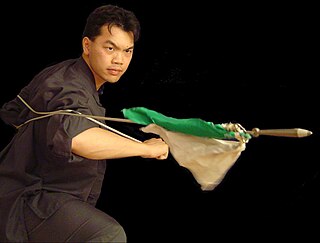
The rope dart or rope javelin, is one of the flexible weapons in Chinese martial arts. Other weapons in this family include the meteor hammer, flying claws, Fei Tou flying weight, and chain whip.
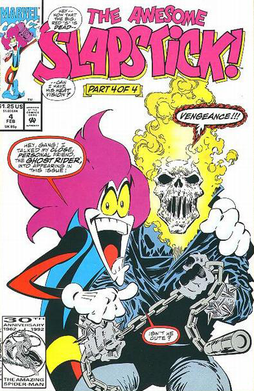
Slapstick is a fictional superhero appearing in American comic books published by Marvel Comics. He resembles an animated clown and has the abilities of a slapstick cartoon character, such as one from Looney Tunes, including warping reality to match that of an animated cartoon.

A quest, or mission, is a task in video games that a player-controlled character, party, or group of characters may complete in order to gain a reward. Quests are most commonly seen in role-playing games and massively multiplayer online games. Rewards may include loot such as items or in-game currency, access to new level locations or areas, an increase in the character's experience in order to learn new skills and abilities, or any combination of the above.

The harisen is a giant paper fan, usually made in a closed fashion. It is most traditionally used as part of a manzai act, in which the straight man smacks the funny man in response to their jokes or idiocy.

A trigger is a mechanism that actuates the function of a ranged weapon such as a firearm, airgun, crossbow, or speargun. The word may also be used to describe a switch that initiates the operation of other non-shooting devices such as a trap, a power tool, or a quick release. A small amount of energy applied to the trigger leads to the release of much more energy.

Super Mario is a platform game series created by Nintendo starring their mascot, Mario. It is the central series of the greater Mario franchise. At least one Super Mario game has been released for every major Nintendo video game console. However, there have also been a number of Super Mario video games released on non-Nintendo gaming platforms. There are more than 20 games in the series.

Animal Crossing is a social simulation video game series developed and published by Nintendo. The series was conceptualized and created by Katsuya Eguchi and Hisashi Nogami. In Animal Crossing, the player character is a human who lives in a village inhabited by various anthropomorphic animals and can do various activities like fishing, insect catching, and fossil hunting. The series is notable for its open-ended gameplay and use of the video game console's internal clock and calendar to simulate real passage of time.
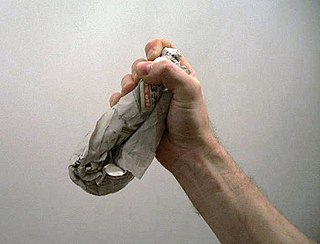
A Millwall brick or bat is an improvised weapon made of a manipulated newspaper, used as a small club. It was named after supporters of Millwall F.C., who have a reputation for football hooliganism. The Millwall brick was allegedly used as a stealth weapon at football matches in England during the 1960s and 1970s. The weapon's popularity appears to have been due to the wide availability of newspapers, the difficulty in restricting newspapers being brought into football grounds, and the ease of its construction.
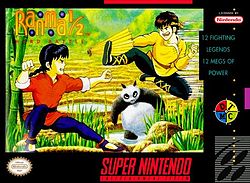
Ranma ½: Hard Battle, known as Ranma ½: Bakuretsu Rantōhen in Japan and as just Ranma ½ in Europe, is a 2-D fighting video game released by Masaya and DTMC for the Super Nintendo Entertainment System. It is based on the manga and anime series Ranma ½. Hard Battle is the second Ranma ½ game to be translated into English, this time keeping the original graphics, music, and names of the characters, though the voices were still dubbed into English. The game's English translation was provided by Viz Media.
In pen and paper games and computer and video games, an item is an object within the game world that can be collected by a player or, occasionally, a non-player character. These items are sometimes called pick-ups.
In the Dungeons & Dragons fantasy role-playing game, a magic item is any object that is imbued with magic powers. These items may act on their own or be the tools of the character possessing them. Magic items have been prevalent in the game in every edition and setting, from the original edition in 1974 until the modern fifth edition. In addition to jewels and gold coins, they form part of the treasure that the players often seek in a dungeon. Magic items are generally found in treasure hoards, or recovered from fallen opponents; sometimes, a powerful or important magic item is the object of a quest.
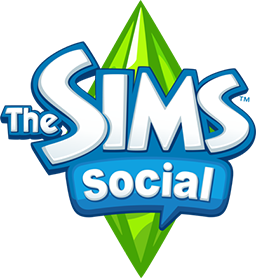
The Sims Social was a Facebook addition to the Sims series of video games. It was announced during the Electronic Entertainment Expo 2011 press conference. As with the original Sims games, The Sims Social lets the user create their own customizable character. In this version, however, the player uses their character to interact with those of their Facebook friends. The characters can develop likes or dislikes for other Sims, creating relationships that can be publicized on the user's Facebook page.
This is a non-comprehensive list that includes terms used in video games and the video game industry, as well as slang used by players.













